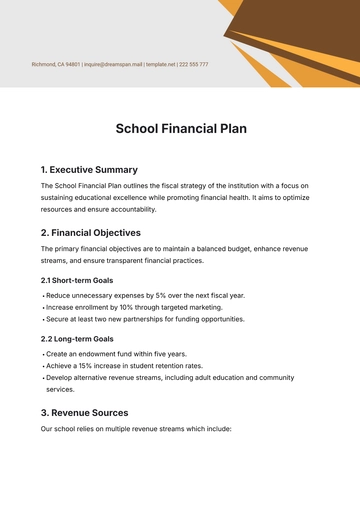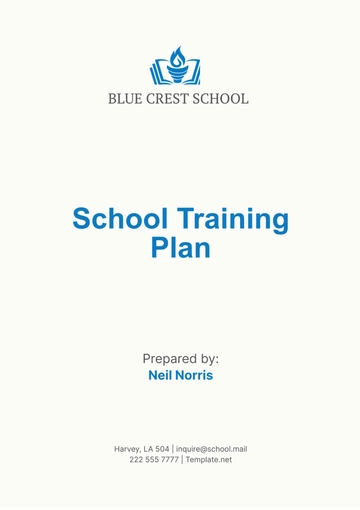Free School Funding Plan

1. Introduction
The purpose of this funding plan for [Your Company Name] is to ensure that all financial resources are allocated effectively to enhance student achievement, support faculty development, maintain school infrastructure, and promote extracurricular opportunities. This plan covers fiscal year 2050 and outlines the strategies, funding sources, budget breakdown, and accountability measures to meet these objectives.
2. Funding Objectives
To deliver a high-quality, equitable education for all students.
To support teachers with development, tech, and resources.
To maintain a safe and modern learning environment with updated infrastructure.
Broaden extracurricular programs for student interests and well-being.
To allocate funds equitably across academic, administrative, and operational needs.
3. Funding Sources
Local Government Funding: Greenfield High will receive an estimated $12.5 million in local property taxes and state-matching funds.
State and Federal Grants: The school plans to apply for $2 million in state grants, including Title I for economically disadvantaged students and $500,000 for STEM programs.
Private Donations: The school aims to raise $500,000 through private donations, partnerships with local businesses, and alumni contributions.
Fundraising Events: A series of events, including a spring auction and a winter charity run, will raise an expected $100,000.
Grants from Nonprofit Organizations: We anticipate receiving $250,000 in grants from educational nonprofits and foundations.
4. Budget Breakdown (for Fiscal Year 2050)
Instructional Costs:
Teacher salaries and benefits: $6,000,000
Classroom supplies and resources (books, materials, technology): $1,000,000
Professional development and teacher training: $500,000
Special education resources: $750,000
Administrative Costs:
School leadership salaries: $1,200,000
Office supplies, administrative materials: $100,000
Technology for administrative use: $250,000
Operational Costs:
Facility maintenance (repairs, custodial services, utilities): $1,000,000
Security and safety (staffing, security systems, equipment): $300,000
Transportation (bus service, fuel, vehicle maintenance): $400,000
Extracurricular Programs:
Sports teams and after-school activities: $300,000
Music, art, and theater programs: $200,000
Clubs and student organizations: $150,000
Technology Costs:
Purchase of computers, tablets, and classroom tech: $1,000,000
IT support staff: $250,000
Online learning resources and platforms: $500,000
5. Allocation of Funds
Funds will be distributed across the following categories to ensure strategic support for both academic needs and operational sustainability:
Instructional Support (40%): $6,000,000 will be dedicated to teacher salaries, professional development, and classroom materials to ensure the best educational outcomes for students.
Operational Support (30%): $4,500,000 will be allocated to maintaining the school’s facilities, providing transportation, and ensuring safety and security.
Extracurricular Support (15%): $2,000,000 will go toward supporting after-school programs, sports, and arts programs.
Technology and Innovation (10%): $1,750,000 will be directed toward integrating cutting-edge technology in classrooms and administrative systems.
Administrative and Miscellaneous Costs (5%): $750,000 will support school leadership, office supplies, and contingencies.
6. Fund Allocation Justification
The funding priorities are designed to enhance [Your Company Name]'s educational experience while ensuring its long-term financial sustainability. This allocation maximizes support for classroom instruction and extracurriculars while also ensuring operational efficiency.
7. Financial Tracking and Accountability
Budget Monitoring: The school’s finance team will track monthly expenditures and compare them with the approved budget. Any discrepancies or overages will be reported and addressed immediately.
Reporting: A quarterly financial report will be shared with school stakeholders, including the school board, parents, and community members. This will include a summary of how funds are being spent and progress toward achieving educational goals.
Audits: An independent audit will be conducted annually by a certified accounting firm to ensure transparency and proper financial management.
8. Contingency Planning
A contingency reserve fund of $500,000 will be set aside for unforeseen expenses such as emergency repairs or unanticipated increases in student enrollment. This reserve represents 5% of the total budget for the fiscal year.
9. Conclusion
[Your Company Name]’s funding plan for 2050 is designed to ensure that financial resources are used effectively to support both the academic success of students and the operational efficiency of the school. Regular monitoring, transparent reporting, and the establishment of contingency funds will ensure that we remain on track to meet our objectives and provide the highest quality education to our students.
- 100% Customizable, free editor
- Access 1 Million+ Templates, photo’s & graphics
- Download or share as a template
- Click and replace photos, graphics, text, backgrounds
- Resize, crop, AI write & more
- Access advanced editor
Streamline your funding goals with Template.net’s School Funding Plan Template. Customizable and editable, it details financial strategies and grant proposals. Editable in our AI Editor Tool, this template ensures a professional and comprehensive funding outline. Download it to secure necessary resources.
You may also like
- Finance Plan
- Construction Plan
- Sales Plan
- Development Plan
- Career Plan
- Budget Plan
- HR Plan
- Education Plan
- Transition Plan
- Work Plan
- Training Plan
- Communication Plan
- Operation Plan
- Health And Safety Plan
- Strategy Plan
- Professional Development Plan
- Advertising Plan
- Risk Management Plan
- Restaurant Plan
- School Plan
- Nursing Home Patient Care Plan
- Nursing Care Plan
- Plan Event
- Startup Plan
- Social Media Plan
- Staffing Plan
- Annual Plan
- Content Plan
- Payment Plan
- Implementation Plan
- Hotel Plan
- Workout Plan
- Accounting Plan
- Campaign Plan
- Essay Plan
- 30 60 90 Day Plan
- Research Plan
- Recruitment Plan
- 90 Day Plan
- Quarterly Plan
- Emergency Plan
- 5 Year Plan
- Gym Plan
- Personal Plan
- IT and Software Plan
- Treatment Plan
- Real Estate Plan
- Law Firm Plan
- Healthcare Plan
- Improvement Plan
- Media Plan
- 5 Year Business Plan
- Learning Plan
- Marketing Campaign Plan
- Travel Agency Plan
- Cleaning Services Plan
- Interior Design Plan
- Performance Plan
- PR Plan
- Birth Plan
- Life Plan
- SEO Plan
- Disaster Recovery Plan
- Continuity Plan
- Launch Plan
- Legal Plan
- Behavior Plan
- Performance Improvement Plan
- Salon Plan
- Security Plan
- Security Management Plan
- Employee Development Plan
- Quality Plan
- Service Improvement Plan
- Growth Plan
- Incident Response Plan
- Basketball Plan
- Emergency Action Plan
- Product Launch Plan
- Spa Plan
- Employee Training Plan
- Data Analysis Plan
- Employee Action Plan
- Territory Plan
- Audit Plan
- Classroom Plan
- Activity Plan
- Parenting Plan
- Care Plan
- Project Execution Plan
- Exercise Plan
- Internship Plan
- Software Development Plan
- Continuous Improvement Plan
- Leave Plan
- 90 Day Sales Plan
- Advertising Agency Plan
- Employee Transition Plan
- Smart Action Plan
- Workplace Safety Plan
- Behavior Change Plan
- Contingency Plan
- Continuity of Operations Plan
- Health Plan
- Quality Control Plan
- Self Plan
- Sports Development Plan
- Change Management Plan
- Ecommerce Plan
- Personal Financial Plan
- Process Improvement Plan
- 30-60-90 Day Sales Plan
- Crisis Management Plan
- Engagement Plan
- Execution Plan
- Pandemic Plan
- Quality Assurance Plan
- Service Continuity Plan
- Agile Project Plan
- Fundraising Plan
- Job Transition Plan
- Asset Maintenance Plan
- Maintenance Plan
- Software Test Plan
- Staff Training and Development Plan
- 3 Year Plan
- Brand Activation Plan
- Release Plan
- Resource Plan
- Risk Mitigation Plan
- Teacher Plan
- 30 60 90 Day Plan for New Manager
- Food Safety Plan
- Food Truck Plan
- Hiring Plan
- Quality Management Plan
- Wellness Plan
- Behavior Intervention Plan
- Bonus Plan
- Investment Plan
- Maternity Leave Plan
- Pandemic Response Plan
- Succession Planning
- Coaching Plan
- Configuration Management Plan
- Remote Work Plan
- Self Care Plan
- Teaching Plan
- 100-Day Plan
- HACCP Plan
- Student Plan
- Sustainability Plan
- 30 60 90 Day Plan for Interview
- Access Plan
- Site Specific Safety Plan





























